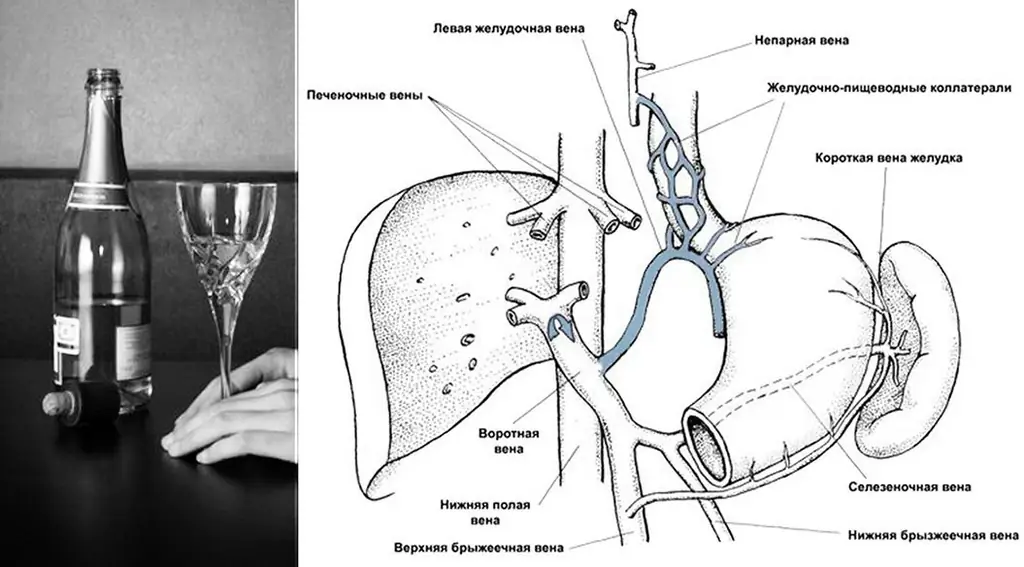- Author Adrian Jeff [email protected].
- Public 2023-12-17 05:06.
- Last modified 2025-01-24 14:09.
A case from medical practice. Cirrhosis of the liver in a cutaneous man
Patient born in 1958. He applied for a disability group regarding the established diagnosis of liver cirrhosis. I remember it as a vivid example of a dermal man who lost his realization.
Patient born in 1958. He applied for a disability group regarding the established diagnosis of liver cirrhosis. I remember it as a vivid example of a dermal man who lost his realization.
He was tall (not less than 190 cm), asthenic physique, slightly stooped. The hair is relatively thick, with moderate gray hair, without bald spots. Contact, answered questions in monosyllables, in short phrases, wore a watch on his left wrist.

From the anamnesis: the diagnosis of liver cirrhosis was established when last year the patient was urgently taken to the surgical department of the city hospital with internal bleeding, before that he felt general malaise, irritability, causeless anxiety and fussiness, fatigue, loss of appetite.
Prior to that, for more than 10 years, he worked first as an administrator in a sanatorium, then, having organized a private enterprise with his wife, he began to sell vouchers to a sanatorium for various enterprises. This work requires certain skills, including communication skills, the ability to be the first to guess the slightest hint of demand among enterprises for employee health improvement in any region of the non-European part of the country. He was able to profitably calculate the optimal reservation of rooms in a sanatorium, find a good balance of seasonal and off-season workload.
The patient described himself as enterprising, energetic and ready to prove his superiority in business, but at the same time expressed despair about wasted time and about the inability to fit into complex schemes in the area of business that he chose. During the conversation, from time to time with a share of envy, he let go of remarks about contacts with high officials during his work as an administrator of a departmental sanatorium, their attributes of power and financial solvency. It was clear how important a high social status was for him.
The patient noted that over the past years especially, he experienced increasing stress at work. The business was given every year more difficult, the number of sanatorium and resort establishments has been constantly decreasing since the beginning of its activity. Income fell steadily.
Alcohol abuse increased in inverse proportion to the decrease in the patient's income. He often drank with a neighbor. I used exclusively red dry wine "Cabernet". With a bit of bragging, he insisted that he drank up to 3 liters a day in person, almost daily, while his neighbor drank vodka with him.
The feasts continued for several years, right up to an immediate emergency hospitalization with open stomach bleeding.
System analysis
The presence of a skin vector in a person gives the desire and ability to do business. These people are often thin, tall. Flexible enough in business, ambitious and taking advantage of every opportunity to benefit. They are economical, sometimes to the point of stinginess, and rational. Speech, as a rule, is laconic, laconic. The urethral mental superstructure gives boasting, a tendency to exaggerate their achievements, social status. They are ready to prove their superiority in any aspect in the competition.

For the most part, leather workers are attentive to their health. They keep themselves in shape, do not allow too much, practically do not consume large quantities of strong drinks, prefer wines to vodka, better and more expensive, if the wallet allows.
In a developed state, a leather worker is a lawmaker and law-abiding, in an undeveloped state, he is prone to theft and corruption. Suffers to the utmost from demotion and loss of material wealth. As an extreme, in the absence of realization in society - alcoholism without any restrictions. They are the ones who become "drinking alcoholics". In our example, most likely, the illness to some extent protected the patient from the social bottom, leaving him as compensation memories of a successful business and a memory of a high status.
What's happening?
Any stress, even formally compensated, has a huge effect on the body, including the synthesis of hormones and neuropeptides. A person lives according to the principle of growing pleasure, and it is very difficult for us to come to terms with even a slight shortfall. Our expectations are not confirmed, disappointments cause pain and suffering, even if we do not externally show it.
Serotonin is one of those hormones whose activity is associated with feelings of contentment and increased mood. He is also responsible for self-control and emotional stability. In addition to the brain, its synthesis is carried out in the intestines, hence the person, as they say, "seizes" stress - the fastest, but not always the correct way to restore internal balance.
Alcohol also relieves emotional tension and stimulates appetite. Instead of looking for a way out of the current crisis, it is certainly easier to have a drink and a snack in a company, it is less energy intensive. In order to look for ways out of this situation, you need to have a very flexible skin vector. Apparently, in our case, this was not enough.

For reference: With cirrhosis, the so-called portal hypertension develops - an increase in blood pressure in the portal vein system, since the free flow of blood through the liver is disturbed. Normally, approximately ¼ of the cardiac output (about 1500 ml of blood) passes through the liver. 1/3 of this amount of blood is carried by the hepatic artery, and 2/3 by the portal vein. In both the prehepatic and intrahepatic block, the blood of the portal system is not able to enter the vena cava system in the normal way (through the liver). As a result of portal hypertension, normally non-functioning veins open, which lie shallowly in the submucosa of the esophagus and stomach, they are easily injured by the action of gastric contents or rough food, and bleeding occurs from them, which is very difficult to stop without surgery. Only 35% of patients with cirrhosis survive the first major bleeding, even if they receive an appropriate amount of blood transfusion. A year after the first major bleeding, 70% die, and after two years - 80% of patients with cirrhosis.






